模块五第一单元project 教案
- 格式:doc
- 大小:64.50 KB
- 文档页数:4
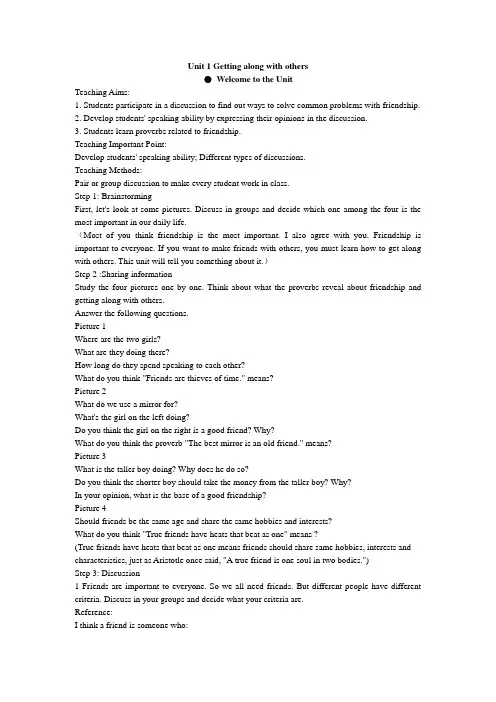
Unit 1 Getting along with others●Welcome to the UnitTeaching Aims:1. Students participate in a discussion to find out ways to solve common problems with friendship.2. Develop students' speaking ability by expressing their opinions in the discussion.3. Students learn proverbs related to friendship.Teaching Important Point:Develop students' speaking ability; Different types of discussions.Teaching Methods:Pair or group discussion to make every student work in class.Step 1: BrainstormingFirst, let's look at some pictures. Discuss in groups and decide which one among the four is the most important in our daily life.(Most of you think friendship is the most important. I also agree with you. Friendship is important to everyone. If you want to make friends with others, you must learn how to get along with others. This unit will tell you something about it.)Step 2 :Sharing informationStudy the four pictures one by one. Think about what the proverbs reveal about friendship and getting along with others.Answer the following questions.Picture 1Where are the two girls?What are they doing there?How long do they spend speaking to each other?What do you think "Friends are thieves of time." means?Picture 2What do we use a mirror for?What's the girl on the left doing?Do you think the girl on the right is a good friend? Why?What do you think the proverb "The best mirror is an old friend." means?Picture 3What is the taller boy doing? Why does he do so?Do you think the shorter boy should take the money from the taller boy? Why?In your opinion, what is the base of a good friendship?Picture 4Should friends be the same age and share the same hobbies and interests?What do you think "True friends have heats that beat as one" means ?(True friends have heats that beat as one means friends should share same hobbies, interests and characteristics, just as Aristotle once said, "A true friend is one soul in two bodies.")Step 3: Discussion1 Friends are important to everyone. So we all need friends. But different people have different criteria. Discuss in your groups and decide what your criteria are.Reference:I think a friend is someone who:*is trustworthy*is honest, affectionate and loving*shares happiness and sorrow*is loyal to me*can point out my mistakes sincerely*is not selfish2. We value friendship today and through the history the ancient people also treasured it very much. They left us many valuable proverbs and sayings. Here are some:1. 多个朋友多条路。
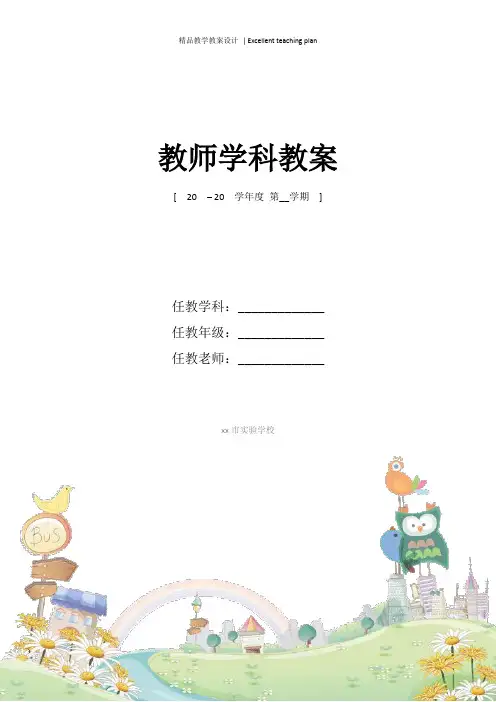
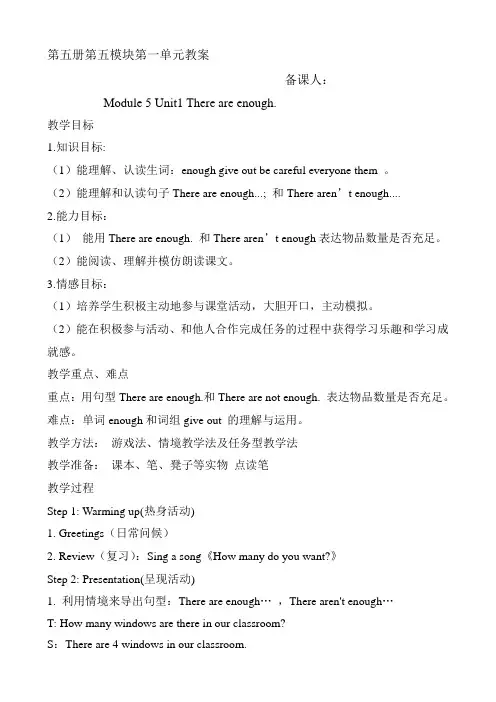
第五册第五模块第一单元教案备课人:Module 5 Unit1 There are enough.教学目标1.知识目标:(1)能理解、认读生词:enough give out be careful everyone them 。
(2)能理解和认读句子There are enough...; 和There aren’t enough....2.能力目标:(1)能用There are enough. 和There aren’t enough表达物品数量是否充足。
(2)能阅读、理解并模仿朗读课文。
3.情感目标:(1)培养学生积极主动地参与课堂活动,大胆开口,主动模拟。
(2)能在积极参与活动、和他人合作完成任务的过程中获得学习乐趣和学习成就感。
教学重点、难点重点:用句型There are enough.和There are not enough. 表达物品数量是否充足。
难点:单词enough和词组give out 的理解与运用。
教学方法:游戏法、情境教学法及任务型教学法教学准备:课本、笔、凳子等实物点读笔教学过程Step 1: Warming up(热身活动)1. Greetings(日常问候)2. Review(复习):Sing a song《How many do you want?》Step 2: Presentation(呈现活动)1. 利用情境来导出句型:There are enough…,There aren't enough…T: How many windows are there in our classroom?S:There are 4 windows in our classroom.T: How many doors are there in our classroom?S:There are 4 doors in our classroom.T: How many students are there in our class?S:There are…T: How many English-books are there in our class?S:There are…T: Are there enough? (呈现enough)S:Yes! There are enough English-books. (教师引导学生回答,并板书)T: There are…students and …English-books. There are enough English-books for everyone. (呈现everyone)T: Everyone gets a desk. There are enough.T: Look! There are some pencils in my hand. How many pencils are there?S:There are …T: Are there enough?S:No! There aren't enough pencils.板书:There are enough English-books. There aren't enough pencils.2.利用游戏来对这一句型进行操练,并导出give out和give …to…T:Let’s play a game.(抢凳子游戏)T:I want to play a game with you. Do you like playing games?(放5张椅子在教室前面,请5位同学上来)T:I want 5 students to come here. There are 5 chairs here. Are there enough chairs? Ss::Yes! There are enough chairs.(引导学生回答)T:You circle the chairs. When I say “stop”, you must sit on one chair. Other students say“There are enough chairs.”Clear? (提醒学生做游戏的时候要小心:呈现careful)Ss::Yes!T:Who wants to try?玩了第一轮游戏后:(搬去一张椅子,5个同学继续玩)T:There are 4 chairs and 5 students.T::Are there enough chairs?Ss::No,there aren’t enough chairs.T:Very good!游戏结束后:T:Ok! You all do a good job. I will give out the presents!(呈现give out)T:Give candy to every actor. (把candy分给每一个表演的同学,呈现every) Step 3. New teaching:①T: Let’s go into the text. Open your book and turn to page 18. Listen to the tape and answer my question.What did Ms Smart buy yesterday?T: Listen again, answer these questions:How many pencils did Ms Smart buy?How many children are there in the class?Are there enough pencils?Ss answer.T:So,there are enough pencils for students. But, why does Sam say“there aren’t enough”?②Read this part again and find out the answer.T:How many pencils does Sam get?S:15.T:How many pencils are there in the blue box?S:10(读一次学生还找不出答案,再读一遍)③Look at the two pictures. What happened to them? Read this part.S:…T:Sam stumbled by John’s bag. And what happened to John’s pencil?S:…T:Yes, John’s pencil is divided into 2 pencils. Who gets 2 pencils?S:John gets 2 pencils.T:Ok! Let’s retell the story.复述:Ms Smart bought 25 pencils yesterday. She asked Sam to give out the pencils for everyone. There are 25 children in the class. But Sam gets only 15 pencils. There are 10 pencils in the blue box. There are enough pencils for everyone. John’s pencil is divided into 2 pencils. John has got 2 pencils.Step 4: Practice(操练活动)1.Read after the tape ,then read this text in roles.2.模仿朗读课文,表演精彩片段。
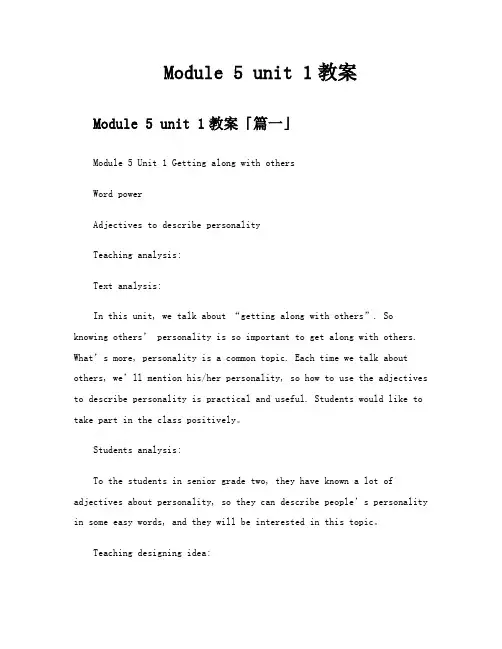
Module 5 unit 1教案Module 5 unit 1教案「篇一」Module 5 Unit 1 Getting along with othersWord powerAdjectives to describe personalityTeaching analysis:Text analysis:In this unit, we talk about “getting along with others”. So knowing others’ personality is so important to get along with others. What’s more, personality is a common topic. Each time we talk about others, we’ll mention his/her personality, so how to use the adjectives to describe personality is practical and useful. Students would like to take part in the class positively。
Students analysis:To the students in senior grade two, they have known a lot of adjectives about personality, so they can describe people’s personality in some easy words, and they will be interested in this topic。
Teaching designing idea:This part is word power, the task for me is to enlarge their vocabulary about the personality, and make students know the significance of the personality to their lives. Make the words really powerful!Teaching aims:Knowledge aims:Know some words about personalities。
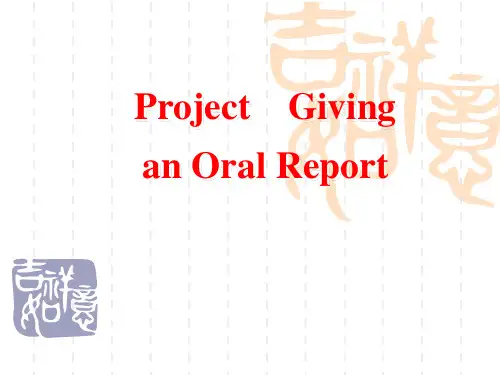
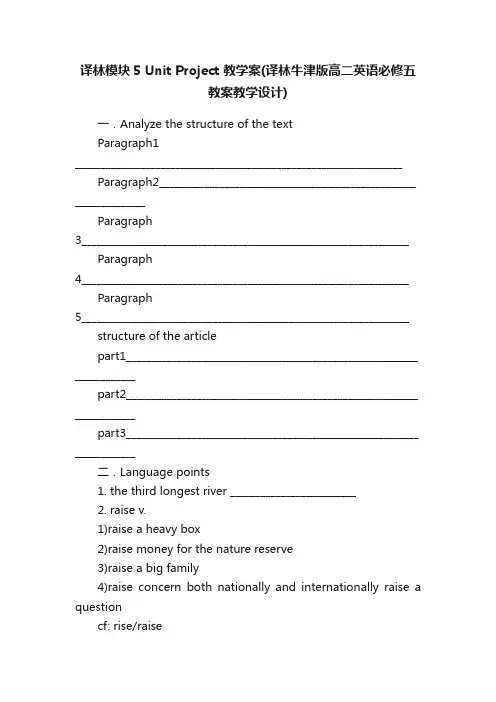
译林模块5 Unit Project 教学案(译林牛津版高二英语必修五教案教学设计)一.Analyze the structure of the textParagraph1_________________________________________________________________ Paragraph2___________________________________________________ ______________Paragraph3_________________________________________________________________ Paragraph4_________________________________________________________________ Paragraph5_________________________________________________________________ structure of the articlepart1__________________________________________________________ ____________part2__________________________________________________________ ____________part3__________________________________________________________ ____________二.Language points1. the third longest river _________________________2. raise v.1)raise a heavy box2)raise money for the nature reserve3)raise a big family4)raise concern both nationally and internationally raise a questioncf: rise/raise3. both nationally and internationally = ___________________________4. not only… but also不仅……而且可连接两个并列的名词,动词,例:He is not only _______________ but also ________________.He not only_________________________, but also ____________________________.not only 放在句首时,句子要倒装观众不仅能感觉到攀登珠穆郎玛峰的每一步,还能感觉到寒冷,疲劳,品尝到食物,闻到气味,感受到山上的风景以及自然界的声音。

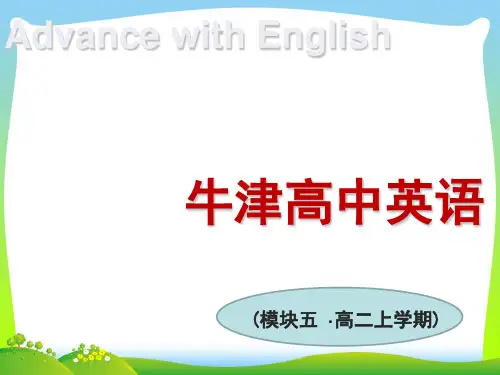
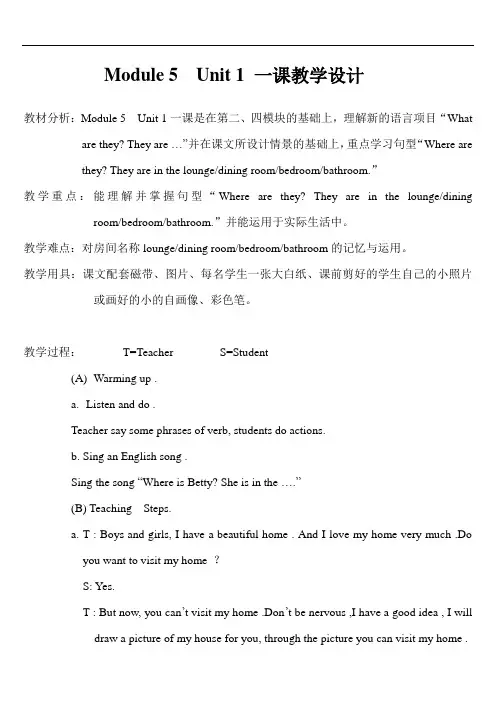
Module 5 Unit 1 一课教学设计教材分析:Module 5 Unit 1一课是在第二、四模块的基础上,理解新的语言项目“What are they? They are …”并在课文所设计情景的基础上,重点学习句型“Where arethey? They are in the lounge/dining room/bedroom/bathroom.”教学重点:能理解并掌握句型“Where are they? They are in the lounge/dining room/bedroom/bathroom.”并能运用于实际生活中。
教学难点:对房间名称lounge/dining room/bedroom/bathroom的记忆与运用。
教学用具:课文配套磁带、图片、每名学生一张大白纸、课前剪好的学生自己的小照片或画好的小的自画像、彩色笔。
教学过程:T=Teacher S=Student(A)Warming up .a.Listen and do .Teacher say some phrases of verb, students do actions.b. Sing an English song .Sing the song “Where is Betty? She is in the ….”(B) Teaching Steps.a. T : Boys and girls, I have a beautiful home . And I love my home very much .Doyou want to visit my home ?S: Yes.T : But now, you can’t visit my home .Don’t be nervous ,I have a good idea , I willdraw a picture of my house for you, through the picture you can visit my home .(教师用学生比较感兴趣的话题——教师的家来引出本课学习内容,在这时学生的注意力很集中,学习效果很好。
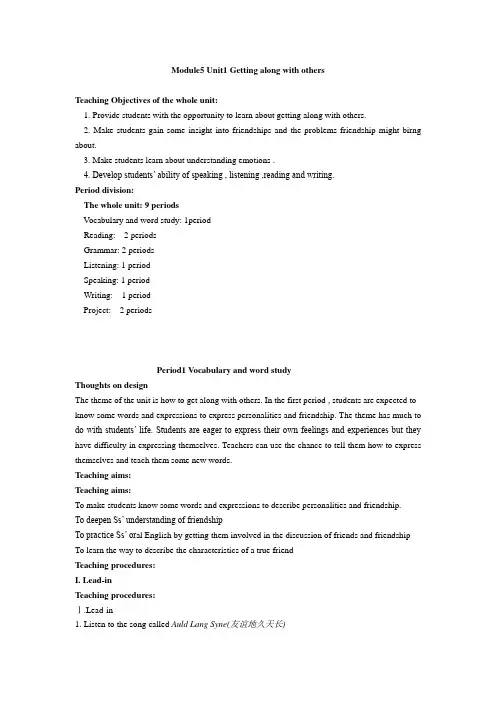
Module5 Unit1 Getting along with othersTeaching Objectives of the whole unit:1. Provide students with the opportunity to learn about getting along with others.2. Make students gain some insight into friendships and the problems friendship might birng about.3. Make students learn about understanding emotions .4. Develop students‟ ability of speaking , listening ,reading and writing.Period division:The whole unit: 9 periodsVocabulary and word study: 1periodReading: 2 periodsGrammar: 2 periodsListening: 1 periodSpeaking: 1 periodWriting: 1 periodProject: 2 periodsPeriod1 Vocabulary and word studyThoughts on designThe theme of the unit is how to get along with others. In the first period , students are expected to know some words and expressions to express personalities and friendship. The theme has much to do with students‟ life. Students are eager to express their own feelings and experiences but they have difficulty in expressing themselves. Teachers can use the chance to tell them how to express themselves and teach them some new words.Teaching aims:Teaching aims:To make students know some words and expressions to describe personalities and friendship.To deepen Ss‟ understanding of friendshipTo practice Ss‟ or al English by getting them involved in the discussion of friends and friendship To learn the way to describe the characteristics of a true friendTeaching procedures:I. Lead-inTeaching procedures:Ⅰ.Lead-in1. Listen to the song called Auld Lang Syne(友谊地久天长)2. Read the title of this unit and tell them that friends are a very important part of their lives.II. Discussion:What kind of person do you want to be your friends and what kind of person don‟t you like ? Students may have difficulty in expressing themselves and the teacher will teach some words to help them. The teacher can refer to the words on P6. Students focus on adjectives which describe people‟s personalities.Ⅲ.Word-learning and experience-telling1. Before asking students to tell their experiences, the teacher tells them: Maybe your experiences with your friends are complicated and various stories have happened between you and your friends. In order to express yourselves more clearly, you'd better learn some more words to help you.2. Let students read the words and expressions and pay more attention to the words they will use to describe their own experience. The teacher explains some key words and expressions: pretend, admit, pay on , forgive, manner, apologize , blame, get through, be based on , eager, regardless of.3. Students are asked to tell their own experiences with their friends first in groups and then before the whole class, using new words as many as possible.HomeworkPrepare some proverbs about friendshipPeriod2 Reading(1)Thoughts on designThis is the first period of Reading. The reading passage is made up of two letters written to a magazine advice columnist. Studnents are asked to understand the whole passages and improve their abilities of reading and thinking. The two letters contain two students‟ emotions when they have fallen out with their best friend. How to understand two students‟ emotions is the key point. After learning the two letters, students will value their friendship.Teaching aims:To deepen Ss‟ in sight into problems between friendsTo practice Ss‟ reading comprehension skillTo identify feelings and emotions in a textTeaching procedures:Ⅰ.Lead-in1. Have you ever fallen out with a very good friend?2. If you had a quarrel with a friend, how would you deal with it?3. How would you mend a broken friendship?II. Read the two letters and answer the following questions according to the requirements. 1. What did Sarah tell Hannah in the girl‟s washroom? (no more than 12 words)She told Hannah how badly she had done in the maths quiz.2. Why did Sarah tell Hannah that they weren‟t going to be friends any more? ( no more than 18 words)Because she thought that Hannah had told her classmates about his grade after promising not to do so.3. What did Matthew think aobut losing the match? (no more than 6 words)He thought it wasn‟t his fault.4. What kind of boy is Matthew? (no more than 6 words)He is usually cheerful and outgoing.Ⅲ. Reading strategy: reading to understand feelings.By reading the letters, it is possible to find out just how the writer feels aobut the problem and even think about what advice to give him \ her.Read the two letters again and fill in the blanks with no more than three words.1 2 ReasonsSarah Ashamed Her maths grade was 3 inher class.4 A piece of paper saying …Stupid Sarahgot a D‟ was on her desk.Angry She thought her best friend 5 .AndrewAngry They lost the game because of 6 .7 He made some really cruel remarks toMatthew.Awkward His best friend Matthew has stopped_____8_____.(Answers: 1. Letter writers 2. Feelings 3. the lowest 4. Upset 5. broke her promise 6. Natthew‟s carelessness 7. guilty 8. talking to him )First, let students do it by themselves. Then ask them discuss the answers in groups. Later, two students are asked to come to the blackboard and write down their answers on it. The others check their answers and share their different answers.IV. ConsolidationComplete two letters written by Agony Aunt back to the two students with the proper words. Ⅴ. DiscussionAnalyze the reasons that might lead to a broken friendship.---having little in common---lacking trust---there being conflict of interest---being jealous of each other---being indifferent to each other…HomeworkRetell the two letters.Period3 Reading(2)Thoughts on designIn this period, we focus on the language points, including some key words and expressions, sentences structures and sentence analysis.Teaching aimsStudents will be able to understand the letters better by analysing some difficult sentence patterns and know how to use some key words.Teaching proceduresⅠ Understanding difficult sentences1. (Line8) I must have sounded very proud of myself after the quiz, saying how easy it was an dhow I was sure to get a good grade.2. (Line19) I thought that Hannah must have told my classmates about my grade after promising not to.3. (Line21) I was so angry that I went straight to Hannah and told her we weren‟t going to be friends any more because she couldn't keep her word.4. (Line39) He got annoyed , saying it wasn‟t his fault if he couldn‟t play as well as me, and that I shouldn‟t talk to him in this manner.ⅡThe infinitive and verb-ing form in the lettersUnderline the infinitive and verb-ing form in the letters by themselves and then check before the whole class.ⅢImportant phrasesfeel betrayed feel like doing be determine d to do keep one‟s wordkeep pace with accuse sb of sth belong to as a result ofapologize to sb for sth. keep one‟s secret spy on can't help doing( Ask the students to make up a story using at least six phrases above.)A version: Last year, I found that I fell in love with one boy . I didn‟t feel like telling anyone but my best friend Mary . She promised to keep my secret, saying that the secret only belonged to us two.I was sure that she would keep her word . One day, the boy came to me , telling me that he didn't like me at all. It must be Mary who told him my thought.I felt betrayed and embarrassed andcouldn‟t help crying. …Homework1. Recite the text;2.Finish some exercises related to the key words and language points from the text.Periods4-5 Grammar and usageThoughts on designThe grammar items in this unit focus os the to infinitive, the bare infinitive and the verb-ing form as a noun. Students are expected to recognize the basic forms of the to infinitive and the bare infinitive and learn how to use the verb-ing form as a noun in various situations. At the same timem students are expected to apply what they have learnt by doing osme written tasks.Period 4 Grammar and usage(1)Teaching aims:To recognize the basic forms of the to-infinitive and the bare infinitive.To learn how to use to-infinitives and bare infinitives in different situations.Teaching procedures:Ⅰ. Lead-inRetell the first letter in Reading part by filling in the blanks with the correct forms of the given words.______ (get) along very well with a good friend isn't easy. It‟s a story between Sarah and her best friend Hannah. One Monday, they had a math quiz. Sarah thought it easy __________(get) good results. To her surprise, she had the lowest grade in the class. In class, she pretended ________(be) cheerful , but Hanhah sensed something was wrong. Hannah made Sarah _________(tell) her the truth and Sarah asked Hannah _______(keep) the secret. However, the next day, Sarah f ound a note on her desk, saying “Stupid Sarah got a D”. Sarah thought that Hannah must have told their classmates about her grade . She was so angry that she would give Hannah a chance ________ (explain) further. She lost her best friend and felt sad.Ⅱ. Functions of to-infinitiveAnalyse the functions of to-infinitive according to the words in the blanks.1)subject of a sentence2)object3)object complement4)attribute5)predicative6)adverbialAsk students to draw a conclusion what verbs can be followed be to-infinitive as their object.Ⅲ. Functions of bare infinitive1) We use the bare infinitive after:* let and make and sometimes have* verbs of perception: feel, hear, see and watch* would rather, had better and why not2) When two infinitives are joined by and, or, expect, but, than, rather than, we normally use the bare infinitive for the second infinitive.Ⅵ. Consolidation1. Turn to page 9 and complete the letter.2. Retell the letter to your partner using your own language.Homework1. P.9 Fill in the blankets, using to-infinitives.2. P.92 C1 Answer the questions using to-infinitives.Period 5 Grammar and usage (2)Teaching aims:To recognize the basic form of the verb-ing.To learn how to use the verb-ing form as a noun in different situations.Teaching procedures:Ⅰ. Lead-inRetell the second letter in Reading part by filling in the blanks with the correct forms of the given words.Today I would like _______(tell) you a story between Andrew and his best friend Matthew. Both of them enjoy ________(play) football. Last week, they had an important match against another school. Andrew was looking forward to _______(win) the game, but to his disappointment, they failed as a result of Matthew‟s carelessness. Andrew thought it was Matthew‟s fault ______(lo se) the game and they started ______(shout) at each other with some cruel remarks. Later they stopped _______(talk) to each other . Yesterday, Adrew saw Matthew _______(talk) to another boy, Peter and he couldn't help _________(wonder) if Matthew wanted Peter to be Matthew best friend instead of him. Andrew didn't know how ________(deal) with this problem.Ⅱ.1. Functions of verb-ing1)subject2)predicative3)object4)after possessive pronouns5)in compound nouns2. We use a verb-ing form, not an infinitive after these verbs:admit, dislike, imagine, delay,consider, mind, understand, avoid, enjoy, practise, miss, finish, keep, suggest.3. We can use a verb-ing form or an infinitive after the following verbs, with little difference inmeaning:continue, prefer, begin, hate, like, start, love4. Some verbs can be followed by a verb-ing form or a to-infinitive , but with some different in meaning or usage: forget, regret, remember, mean, try, go onforget + to-infinitive (an activity that has not been done)forget + verb-ing form (an action that has been done)5. Some common phrases are used with verb-ing forms.Would you mind ……cannot help……look forward to……feel like……cannot stand……it is no use/ good……put off……keep on…Ⅲ. ConsolidationComplete the letter on page 11Ⅵ. Discussion:State your opinion on visiting Internet chat rooms.Ⅶ. More exercisesHomework1. P.11 Fill in the blanks, using verb-ing form.2. P.92 Fill in the blanks using the correct forms in blanks.3. Unit Revision: Periods 5 & 6.Periods 6-7 TaskThoughts on design:This section includes a series of activities which provide students with opportunities to learn and practise their listneing, speaking, reading and writing skills. Through these activities, students will learn how to write down the answers, how to express agreement and disagreement, as well as how to check their written work. They will also get some practical advice on making lasting friendships.Period 6 Listening and SpeakingTeaching aims:1. To help students develop their listening skills2. To help students express agreement and disagreement in EnglishTeaching procedures:1. Lead-inWhat do you do when you have a personal problem?Would you talk to your parents or your friends and ask them for advice?Have you ever called a radio programme for advice?II.ListeningRead the leaflet about Teen Talk and do the exercise in Part A to get information about Teen Talk. Then do listening in Part B and do the following exercise.Reasons for calling Teen Talk:·Don‟t know who to 1. ___________Description of the problem:·Have two 2. __________ and they don‟t 3._________Feeling about the problem:·Feel 4. _____________ between the twoTeen Talk’s advice:·5. _____________ to each friend and 6. __________ the problem;·Let the three of you meet 7. _____________Planned actions to overcome the problem:·Write a letter·Ask friends to meet at their favorite cafe 8. __________.·Talk and get to know each other better.(Answers: 1. ask for help 2. important friends 3. like one another 4. divided 5. write a letter 6. explain 7. outside of school 8. on Sunday )III. Speaking1. Let students learn many expressions, apart from Yes and No, to express agreement and disagreement. Read the expressions in Skills building2 on Page 14 and understand them.2. Discuss friendship in groups by choosing at least 3 questions and show their opinions on friendship using the expressions they learn in Skills building2.Discuss the following questions:a. What do you think a best should be like?b. Does having friends make you a better person?c. How do you want your friends to treat you?d. How can friends help you solve your problems?e. What makes a good friendship last?(After they have discussed in groups , two groups will be asked to share their opinions with the whole class.)Homework: Collect more information about friendship to prepare for writing.Period 7 WritingTeaching aims:1. To improve students‟ writing skills2. To make students know how to check their own workTeaching procedures:Step 1. Collect more information about friendshipAsk students to share their information about friendship according to last class‟ questions.Step2. Skills building 3 : checking your workHave students read the tip box on Page16. Make sure they know how to make corrections. And let them read the diary and check for mistakes by themselves. Have them focus on facts, grammar, and writing, puncutation, vocabulary, spelling and style. Then check the answers as a class.Step 3: Writing a letter to your friend1.Write a letter to a friend about what his or her friendship means to you. using information gathered in Step 1 and last class.2.Group work: each member of the group contributes something to the planning of the outline of the letter.3. Write the letter based on the outline in Part A on page 17.4.PresentationLet‟s invite several groups to read their letters to the cla ssHomeworkWrite a letter.Period 8 Project Giving an oral reportThoughts on design:The section is designed to help students learn and use English practically. Students are expected to read two articles about friendship. The first article shows different attitudes that teenage boy and girls have towards friendship, which can help students understand about the differences between teenage boys‟ and girls‟ friendships. The second article tells about the real meaning of friendship, which helps students have a better understanding of friendship.Teaching aims:1. To encourage students to use what they have learned in this unit to complete a project.2. To let students learn how to plan and conduct a survey and how prepare an oral report to present to the class.Teaching procedures:Step 1 lead-inPresent a questionnaire and conduct a survey about different attitudes to friendship between boys and girls with the whole class. QuestionnaireAre you a boy or a girl? Boy GirlTick the answer which most applies to you.1. How many best friends do you have?A lot A few None2. How often do you have a long conversation with your friends?More than three times a week once a week seldom never3. What topics do you mostly talk about with your friends?Hobbies and interests Families and friendsSchool and study Emotions and feelingsFuture plans and dream4.Do you share your secrets with your best friends?Always Sometimes Never5. Do you think boys and girls have the same attitudes towards friendship?Yes No6. If you choose No to Question 5 , what different attitudes do they have?Friendships between girls are usually based on shared emotions and support . However, friendships between boys are usually based on shared activities or interests.Girls seem to have a lot to talk about with their best friends than boys.Girls have more friendships than boys.Step 2 readingSkimmingQuestions:1.What is the passage mainly discussing?2. What puzzles Robert?3. What‟s the difference between boys and girls in their attitudes towards friendship?4. What are boys‟ and girls‟ friendships each based on?Step 3 Group Work(finish project)1. PlanningWork in small groups. You want to survey people to determine how attitudes between boys and girls differ on a certain topic..favourite food hobbies the future familyschool subjects musicMy own topic _____________2.ProducingDiscuss and agree on an each of the following questions:What is the primary purpose of our survey?How many questions will we ask?Who will take our survey?Decide which group members will be responsible for each task.3.PresentingWrite multiple-choice questions that can be answered quickly and are easy to total when the survey is complete.Conduct the survey and calculate the results.briefly discuss the conclusions the group has drawn, based on the survey results. Homework1. Finish the WB exercises(B1, B2, D1, D2)2. Unit Revision: Period 9.。
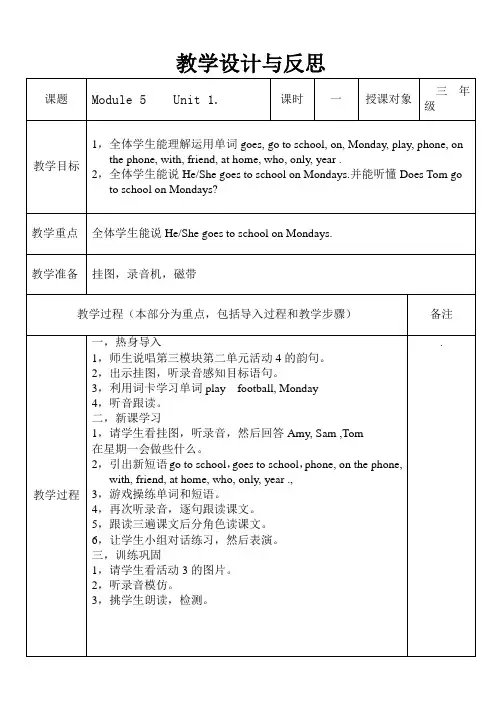
高二(英语)(模块五Unit2 Project)第七课时导学案编制人:王玲审核人:编制时间:8月27日学生完成所需时间35分钟班级:姓名:第小组【学习目标】1.Help Ss learn and use English by doing a project.2. Encourage Ss to use they have learnt to complete a project.【学习重难点】1.Help Ss how to plan and do research for the report.2.How to learn and use English by doing a project.【知识链接】A quiz1)What are the three longest freshwater rivers in the world?2) How much do you know about the Yangtze River ?What has happened to the Yangtze River? Do you know what’s being done to protect this river?【学习过程】Step1: Reading.1. Read the report on page38, try to report the main idea of each paragraph.Paragraph1Paragraph2Paragraph3Paragraph4Paragraph52. More understanding.Why have the environmental problems of the Yangtze River raised the concern both nationally and internationally?What does the green organization do?What problems do the two government projects focus on?What did farmers have to do under the water and soil preservation project?What is the good news for the river?3. Analyze the structure. Divide the text into several parts according to your understanding. Part1 (paragraph )13Part2 (paragraph )Part3 (paragraph )Step2. Language points.1.run across 原文runs across“流经,流过”,across是介词。
也可以表示“横过,穿过”。
一条铁路横越草原。
你能游过去吗?2. plus . not only…but also原文▲plus是介词,而非动词。
意思为“加上”如Two plus five is seven.账款是10美元,再加上1美元邮费。
▲not only… but also不仅……而且,可连接两个并列的名词,动词,例:He is not only a writer but also a cook. He not only read the book, but also remembered what he read.not only 放在句首时,前一个句子要倒装。
我们不仅会参加比赛,而且会赢得比赛。
We take part in the game, but we will also win the game.▲being put back into the river是v-ing 短语的被动形式,在剧中作定语,修饰the waste.本句可以改成一个定语从句。
But the waste being put back into the river has also been increasing.3.rely on. 原文固定词组,与介词on 或upon 连用,表示“依赖,依靠”。
在表示“依赖,依靠”时与depend on同意。
你尽管相信我为你保密。
4.nor原文此处有nor引起的倒装句,nor是副词,作“也不是”解,此句中it指上文中的而上文中的具体内容是。
I will not help him, nor will I help you.他没来,也没打电话给我。
He did not come,同理,由nor 或neither引起的倒装句不能脱离上下文来理解,因为nor或neither总是指代上文中的某个成分。
结构为Nor/Neither+be/have/do/must…+主语,其中的be/have/do随主语的人称而变化,而情态动词或助动词则应同上文所用一致。
他不是北京人,我也不是。
He isn’t from Beijing,我未曾去过美国,他也未去过。
I haven’t ever been to America,5.resulted in 原文result in导致= lead toresult from= due tolead to导致(某种结果).美德使人快乐。
6. have harmful effects on对…产生影响原文这药对他无效。
have an effect on/ have effects on对……有影响have a harmful/positive/great effect on (influence, impact)14go/come into effect 施行,实行,生效The new seat-belt regulations (生效)last week.7. under way 原文under way在进行中under construction 建设中under discussion 讨论中这个问题正在讨论中。
= The question is这个案件正在调查之中。
= The case is8. work out原文▲assess:确定,评定某数额/某事物的价值/某事物的性质总统讲话的巨大影响很难估量。
▲work out拿出,制定出。
还可以表示“设计出,耗出,算出”They have (设计出)a method of sending a spacecraft to mars他好像永远不会疲倦似的。
他很快算出这道数学题。
▲solutions to the many problems:to是介词,意为:…的…对那些问题的回答9.the number of原文the number of…的数目,数字。
后接名词复数形式,但句中谓语动词用单数。
儿童图书馆的数目正在增加。
a number of意为“一些,很多”,后接可数名词复数形式,谓语动词用复数形式。
已经出现了一些问题。
10. remain原文▲此处remain是联系动词,与stay同义,可以互换。
如Please remain/stay here till I return. remain 作连系动词时,还可以表示“保持”,“仍旧是”后面可接形容词,分词,名词和介词短语。
The man (仍旧谦虚有礼)after his election to high office.Mr Smith became an engineer but Mr Brown (还是工人)。
We will (与他们保持联系)。
The true author of the book .(依然不详)She (依然坐着) though we repeatedly asked her to sit down.▲remain也有“剩下”“还有”A few flowers still on the tree.11. prohibited from原文prohibit sb/sth from doing sth禁止某人或某事物做某事(由指法令、法规或条例)同义词forbidforbid doing sth/forbid sth/be forbidden to do sth/forbid sb to do sth法律禁止烟贩(tobacconist) 向儿童出售香烟。
12. have a long way to go原文提高英语水平,我们还有很长的路要走。
Step3. Some useful phrases.世界第三大河引起了国内外的关注工业的飞速发展加上人口的迅猛增长水量会放到长江的废弃物15未处理的人类生活污水和工业污水被沉积到依赖导致对长江流域的生态也产生了盛影响意识到…的重要性设立已经威胁到野生动物的数量正在实施中针对,致力于试图拿出可能的解决方案…的家园渔船禁止进入这片海域有很长的路要走是某人的责任挚爱的河流Step4.重点句型背诵。
1.作为世界第三大河,长江的问题之所以引起了国内外的关注,其原因是显而易见的。
2.工农业的迅猛发展,加上人口的迅猛增长,不仅意味着从长江的取水量在增长,会放到长江的废弃物也在增加。
3.这对居住在长江两岸、饮用水需要依赖长江的所有城镇居民来说并不是好消息。
4.对生活在长江中的鱼类及沿岸的各种野生动植物来说也不是好消息。
5.河水污染的后果是饮用水的不安全,这给生活在长江附近的居民带来各种健康问题。
6.所幸的是,很多人已经意识到保护环境的重要性,设立了诸多环境组织和项目以试图解决这个问题。
7.绿色江河组织是一个非政府机构,它教育和晓谕人们保护这条大河的重要意义。
8.江是众多鱼类和动物的家园,这其中包括依赖长江生存的珍稀哺乳动物白鳍豚。
9.但值得庆幸的是,人们终于意识到了保护这条大河是他们的责任。
10.我们相信,中国政府和人民保护这条他们所挚爱的河流的努力在将来是会得到后人肯定。
Step5.【目标反思】亲爱的同学们,学完Project后,你掌握了那些词组句型,还有什么不明白的地方?请列出来。
关于环境保护,你又有哪些想法?16。